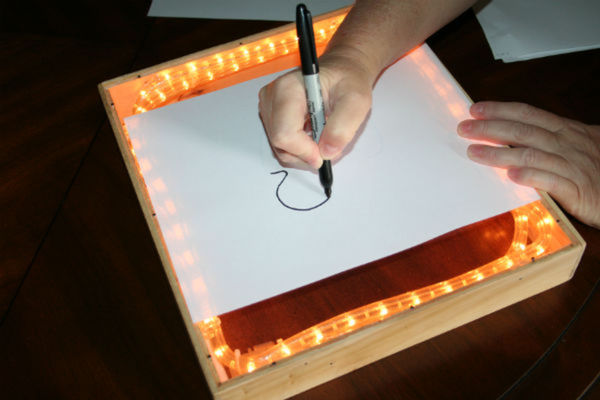Build a tracing table
Build a simple tracing table using a shallow box, clear plastic or tracing paper, LED string lights or a phone flashlight, and practice tracing images.



Step-by-step guide to build a tracing table
Trace Tables | Test your code with Trace Tables
Step 1
Gather all the materials listed and bring them to your workspace so everything is ready.
Step 2
Turn the shallow box so the open side faces up so you have a flat opening to work with.
Step 3
Measure the clear plastic or tracing paper against the box opening and mark where to cut.
Step 4
Use scissors to cut the clear plastic or tracing paper to fit the box opening exactly.
Step 5
Tape the clear plastic or tracing paper over the box opening so it is smooth and flat with no wrinkles.
Step 6
Place the LED string lights or the phone flashlight inside the box along the bottom and arrange them so they shine up under the plastic.
Step 7
Slide the image you want to trace inside the box directly under the plastic so the picture is centered where you will trace.
Step 8
Turn the lights or phone flashlight on so the picture shows clearly through the plastic.
Step 9
Lay a sheet of plain paper on top of the plastic where the picture is lit and hold it steady with one hand.
Step 10
Use a pencil to carefully trace the lines you see through the plastic until your whole picture is traced.
Step 11
Remove your traced paper and use colouring materials to color and decorate your traced drawing.
Step 12
Take a photo of your finished tracing table creation and share it on DIY.org
Final steps
You're almost there! Complete all the steps, bring your creation to life, post it, and conquer the challenge!


Help!?
What can I use if I don't have the LED string lights or a phone flashlight?
Use a small desk lamp, a tablet screen placed face-up inside the box, or battery tea-lights set along the bottom to follow the step that says 'place the LED string lights or the phone flashlight inside the box' so the picture lights up.
My tracing paper or plastic keeps wrinkling and the image looks blurry—how do I fix that?
Follow the instruction to 'tape the clear plastic or tracing paper over the box opening' and press out wrinkles with your fingers, adding extra tape around the edges so the surface is smooth and flat.
How can I adapt this activity for a toddler versus a teen?
For toddlers, an adult should pre-cut and tape the clear plastic, place a bold high-contrast image and hold the paper while they trace, and for teens let them cut and tape the plastic themselves, use detailed images and fine-tip pens for precise tracing.
How can we extend or personalize the tracing table project after tracing?
Try placing colored cellophane over the 'LED string lights or the phone flashlight' for colored outlines, layer two images inside the box before tracing for mixed designs, and use different 'colouring materials to color and decorate your traced drawing' or decorate the box exterior.
Watch videos on how to build a tracing table
Trace Tables with HasNext/GetNext Pseudocode Algorithms - Step-by-Step Lesson from the Classroom
Facts about tracing and drawing for kids
🔋 Battery-powered LED string lights use very little power and can often run for dozens of hours on a small pack, making them great for portable tracing setups.
💡 Lightboxes (or light tables) are used by animators and photographers to trace and line up images — traditional animated features often required tens of thousands of hand-drawn frames.
🎨 Many artists use tracing as a learning tool — tracing helps beginners study shapes, proportions, and composition before freehand drawing.
🔦 Modern phone flashlights use LEDs that are bright and energy-efficient, so a phone can work as the light source for a kid-friendly tracing table.
🧾 Tracing paper became widely used in the 19th century and is semi-transparent so artists can see layers beneath for accurate tracing.
How do you build a tracing table?
What materials do I need for a tracing table?
What ages is this activity suitable for?
What safety tips should I follow when using a tracing table?


One subscription, many ways to play and learn.
Only $6.99 after trial. No credit card required



